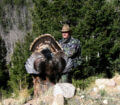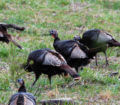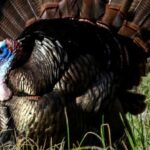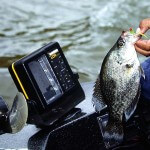Editor’s Note: What many people don’t know about Wayne Carlton of Montrose, Colorado, is that for most of his life outdoorsmen knew him more for his turkey calling and hunting skills rather than hunting elk. Carlton has helped develop many elk calls and has been very active in the Rocky Mountain Elk Foundation organization and shows. But, before he moved to the West, Wayne Carlton had his own line of turkey calls and was known across the East as a very-good turkey hunter and turkey caller. Carlton frequently does turkey hunting seminars and still loves to call, hunt and teach turkey hunting.
 Before I tell you my most-frequently-asked turkey-hunting questions and the answers to them, remember that I teach most of my seminars in the West. In many sections of the West, we’ve only been using shotguns and turkey calls for turkeys within the last 20 years. Up until that time, hunters took turkeys with the same rifles they used for hunting deer and elk. Therefore, many of my most-frequently-asked seminar questions may seem a bit basic, but you have to remember that many western hunters haven’t had daddies, granddaddies or great-granddaddies who always have hunted turkeys or have taught them to hunt turkeys like some turkey hunters in the East have had. I hunt and teach hunters to hunt primarily Merriam’s turkeys, Rio Grande turkeys and eastern turkeys in the western states that have them.
Before I tell you my most-frequently-asked turkey-hunting questions and the answers to them, remember that I teach most of my seminars in the West. In many sections of the West, we’ve only been using shotguns and turkey calls for turkeys within the last 20 years. Up until that time, hunters took turkeys with the same rifles they used for hunting deer and elk. Therefore, many of my most-frequently-asked seminar questions may seem a bit basic, but you have to remember that many western hunters haven’t had daddies, granddaddies or great-granddaddies who always have hunted turkeys or have taught them to hunt turkeys like some turkey hunters in the East have had. I hunt and teach hunters to hunt primarily Merriam’s turkeys, Rio Grande turkeys and eastern turkeys in the western states that have them.
1) How do you sit in the woods when turkey hunting?
Carlton: I try to sit with a tree or a rock at my back to break up my silhouette. I like to lean back when I shoot, but I also want to be sitting up off the ground to see better. If the ground’s wet, then my fanny doesn’t get wet. I like a seat that’s designed for turkey hunters. You also want to learn to point your shoulder and not your chest at a turkey when he approaches.
2) How do you dress for turkey hunting?
Carlton: Don’t forget that western hunters are accustomed to hunting in blue jeans and work shirts. Camouflage is a relatively-new idea to western hunters, and headnets, gloves and camo boots are the newest form of camouflage. Hunters in the West may often buy camo shirts and camo pants, put on their cowboy hats and go hunting. So, I usually explain that you have to have your hands, face, gun and boots camouflaged. One of the biggest problems that western hunters have, especially western hunters with white hair, is that white hair can spook a turkey. I advise the hunters in my seminars to wear either half-headnets that can be pulled up around the backs of their baseball caps and hide their hair or full headnets that cover their entire heads. Remember that turkeys can see further out West than they can in the East. Another reason that total camo is the best way to go when you hunt turkeys in the West is because hunters can see from a long way in open terrain. So, a white hand or a tuft of white hair sticking up out of a ball cap may resemble a turkey’s head. When I call turkeys, I have my back up against a tree or a rock. I’ll have my calls laying out so that I can easily reach them with my right hand. I’ll use a portable ground blind, so that the turkeys won’t see me move.
Carlton: Yes, I do, with a great deal of success. However, if you scare a turkey with a decoy, you’re much more likely to run the bird off than you are to call him to where you’re set-up. One of the reasons that a decoy works so well in the West is because a turkey can see that decoy from a long way. I’ve found that if a turkey comes over a little rise and suddenly spots the decoys, they may spook the tom. I’ve found also the more decoys you use, the more effective your set-up is. You can be a bad caller but set-up right and use enough decoys and still a turkey may come in because the turkeys haven’t been called to as much out in the West as they have in the East. These western turkeys haven’t seen as many decoys out here as the turkeys in the East have.
4) Where do you hunt at different times of the day?
Carlton: In the mornings, instead of going just to the roost, I try and decide where the turkey wants to go when he leaves the roost, and then I move to where he wants to travel. I’ve found that turkeys in the West historically move more and travel more than turkeys in the East. If you’re not between where the turkey is roosting, and where he wants to go, then more than likely you won’t call him. Especially in the morning when that turkey wakes up on the limb, he generally has a particular spot where he wants to go. He’ll be pretty set on going there. If you’re not on the route he normally takes, more than likely you won’t call him to you. In the middle of the day, I’ll take a nap in the woods and then wake up and start calling. Often a turkey will appear. Middle-of-the-day hunting in the West can be very effective, if you’re where the turkey wants to be.
5) If I don’t get my turkey in the morning, how will I take a turkey in the afternoon?
Carlton: Go to where the turkeys will be roosting, and then sit down within 100 to 200 yards of the roost tree. You’ll hear the turkeys coming in at fly-up time because you know the turkeys will return to the same roost where they’ve roosted the previous night. The next morning get close to the turkeys on the roost, set up, and start calling. More than likely, you’ll take a turkey there.
 To learn more about turkey hunting, check out John E. Phillips’ print, Audible, Kindle and Nook turkey books at https://johninthewild.com/books/#turkey and at www.barnesandnoble.com. You also can download a free Kindle app that enables you to read the book on your iPad, computer or SmartPhone. You can learn more about calling turkeys by going to johninthewild.com/audio-files/ for audio turkey tapes to purchase of Lovett Williams, Rob Keck and Chris Kirby, available for download to your SmartPhone, tablet or computer. For a free copy of John E. Phillips’ “The Turkey Gobbler Getter Manual,” go to https://johninthewild.com/free-books/ to download.
To learn more about turkey hunting, check out John E. Phillips’ print, Audible, Kindle and Nook turkey books at https://johninthewild.com/books/#turkey and at www.barnesandnoble.com. You also can download a free Kindle app that enables you to read the book on your iPad, computer or SmartPhone. You can learn more about calling turkeys by going to johninthewild.com/audio-files/ for audio turkey tapes to purchase of Lovett Williams, Rob Keck and Chris Kirby, available for download to your SmartPhone, tablet or computer. For a free copy of John E. Phillips’ “The Turkey Gobbler Getter Manual,” go to https://johninthewild.com/free-books/ to download.

















